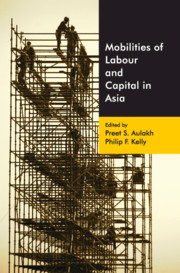Book contents
- Frontmatter
- Contents
- List of Figures
- List of Tables
- List of Appendices
- Acknowledgements
- 1 Introduction: Conceptualizing Labour and Capital Mobilities In and Out of Asia
- SECTION I From Capital to Labour Mobility
- 2 Offshore Spaces: Multi-scalar Bordering Processes and the Segmented Mobilities of Capital and Labour in Asia
- 3 Japanese Multinational Companies and the Control of Overseas Investments: Expatriates, Foreign Employees, and Japan's Soft Power
- 4 Accumulation at the Margins? Mineral Brokerage and Chinese Investments in Philippine Mining
- 5 Soft Power and Transnationalism Affecting Capital and Labour Mobility: Chinese Diaspora in Mexico and Peru
- 6 The Spatial Decoupling and Recombination of Capital and Labour: Understanding the New Flows across the China–South East Asia Borderlands
- SECTION II From Labour to Capital Mobility
- Notes on Contributors
- Index
6 - The Spatial Decoupling and Recombination of Capital and Labour: Understanding the New Flows across the China–South East Asia Borderlands
from SECTION I - From Capital to Labour Mobility
Published online by Cambridge University Press: 24 December 2019
- Frontmatter
- Contents
- List of Figures
- List of Tables
- List of Appendices
- Acknowledgements
- 1 Introduction: Conceptualizing Labour and Capital Mobilities In and Out of Asia
- SECTION I From Capital to Labour Mobility
- 2 Offshore Spaces: Multi-scalar Bordering Processes and the Segmented Mobilities of Capital and Labour in Asia
- 3 Japanese Multinational Companies and the Control of Overseas Investments: Expatriates, Foreign Employees, and Japan's Soft Power
- 4 Accumulation at the Margins? Mineral Brokerage and Chinese Investments in Philippine Mining
- 5 Soft Power and Transnationalism Affecting Capital and Labour Mobility: Chinese Diaspora in Mexico and Peru
- 6 The Spatial Decoupling and Recombination of Capital and Labour: Understanding the New Flows across the China–South East Asia Borderlands
- SECTION II From Labour to Capital Mobility
- Notes on Contributors
- Index
Summary
Introduction
The association between capital and labour varies spatially and shifts temporally. Post-1980 China represents arguably the most striking and largest-scale reconfiguration of international capital and domestic labour. China not only has become the largest recipient in the developing world of foreign direct investment (FDI), most of which has flowed into manufacturing, but has also experienced the largest domestic movement of rural labourers, over 500 million, into city-based factories in history. As this massive combination of capital and labour transformed China into a global economic superpower with abundant foreign reserves and surplus capital, it has turned China into a major new source of capital outflow, mostly into the Global South. Conventional capital mobility is driven primarily by private multinational corporations towards both safe and profitable markets in the Global North and emerging economies with lower production costs and greater market potentials. But China has introduced a new mode of outward capital mobility directed by a strong party-state that also acts as a global capitalist-state. China challenges the prevailing market-capitalist principle and patterns of global capital and labour mobility by unleashing a large wave of capital flow from China to the Global South and thus triggering potentially new but uncertain labour movements within and across national boundaries.
With its powerful role in reshaping a new era of global capital and labour mobility, China offers a timely case for exploring and understanding the spatial reconfiguration of capital–labour relations across a much more expansive swath of the Global South compared to the previous dominance of capital investment from the Global North. By pushing heavy investment into the Global South through such government channels as state development banks and state-owned companies, China presents new questions concerning how a powerful state deals with its weakening domestic economy by sending and steering capital flows to neighbouring national and subnational recipients with weak governance capacities.
This chapter has three purposes. First, we focus on China's heavy capital investment in the Global South, primarily in the least developed part of South East Asia, to understand the formation and consequences of a new zone of cross-border infrastructure-driven regional development. Second, we conduct a two-fold analysis of how Chinese investment in South East Asia differs between a powerful state channel and a more flexible conduit and how this simultaneous but bifurcated capital mobility leads to varied labour movement.
- Type
- Chapter
- Information
- Mobilities of Labour and Capital in Asia , pp. 120 - 150Publisher: Cambridge University PressPrint publication year: 2020



